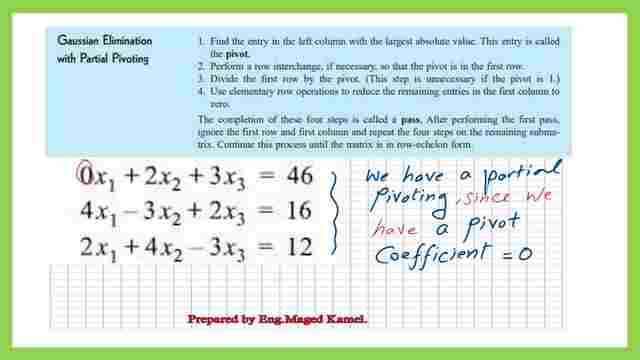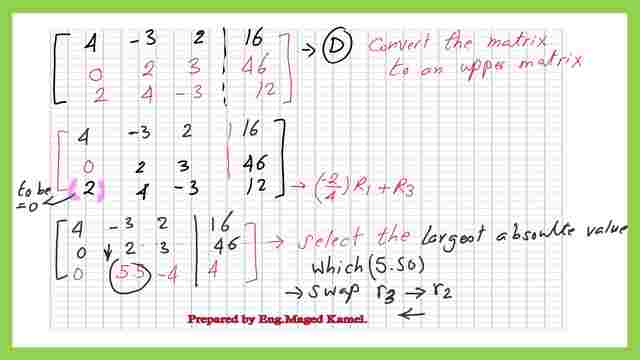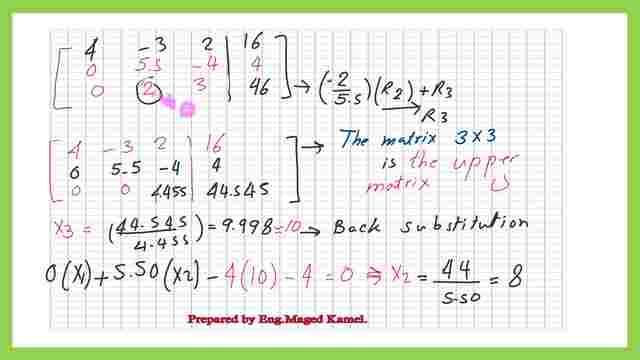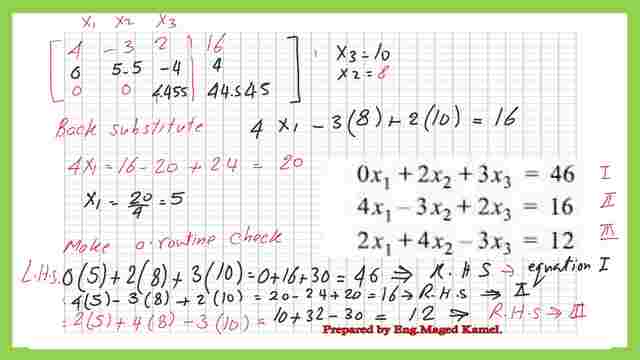Last Updated on August 10, 2025 by Maged kamel
- How to get x1, x2, x3-using Gaussian-partial pivoting?
- How to make Gaussian elimination- case of partial pivoting.
- A solved problem, How to get x1,x2,x3-using Gaussian-partial pivot?
- Make a swap from row1-to row2.
- Write the augmented matrix for the new matrix.
- Create elimination multiplication factors for a21,a31.
- Create an elimination multiplication factor for a32.
- Find the values of x3& x2.
- Find the values of x1.
How to get x1, x2, x3-using Gaussian-partial pivoting?
In this post, we will solve a system of linear equations in Three unknown. Our aim is how to get x1,x2,x3-using Gaussian-partial pivot?
How to make Gaussian elimination- case of partial pivoting.
These steps are quoted from Prof. Ron Larson’s textbook.
The first step is to find the entry in the left column with the largest absolute value, this entry is called the pivot.
The second step is to perform a row exchange, if necessary so that the pivot is in the first row.
The third step is to divide the first row by the pivot.
The fourth step is to use elementary rows operations to reduce the remaining entries in the first column to zero.
A solved problem, How to get x1,x2,x3-using Gaussian-partial pivot?
We have a system of linear equations in three unknowns as follows :*0x1+2*x2+3*x3=46 as the first equation.
4*x1-3*x2+2*x3=16 as the second equation. Finally, 2*x1+4*x2-3*x3=12. It is required to get x1,x2,x3-using a Gaussian-partial pivot.
In the next slide image, we have steps to be used in the case of partial pivoting and the three linear equations.
.As we can see we have a partial pivot =0 since a11=0, we can not divide by zero.

Make a swap from row1-to row2.
We will check the max absolute value of the two entries in the first column, we have 4,2, we will select the max(4,2)=4.
A swap between the first row and the second row will be performed. Our new pivot is 4.

Write the augmented matrix for the new matrix.
We start writing the augmented matrix for the new arrangement of rows, we will convert this coefficient matrix to an upper matrix by eliminating the values of a21, a31.
Create elimination multiplication factors for a21,a31.
Our a21 is already zero. To eliminate a31, we will multiply by (-a31/a11)*R1 add to row-3, and place the result in row 3.
The multiplication factor is(-2/4)=-1/2.
Once we have completed our process of letting a31=0, we will move to the second pivot which is located at ( second column/second row).
We will repeat the same process that we have already done for the selection of the max absolute value of the elements below the pivot, we have only one element which is 5.5.
We will swap row 3 to row2.

The next slide image shows the arrangement of the matrix after the swap between row- 2 to row-3.
Create an elimination multiplication factor for a32.
To let a32=0, we will multiply row2 by(-a32/a22) and add to row3 and place the value in R3. The multiplication factor is(-2/5.5).
Find the values of x3& x2.
After the previous arrangements the form of the upper matrix can be seen and we can get the value of 4.455*x3=44.545, thus x3=10. Perform back substitution to get the value of x2. We have 0*x1+505*x2-4x*x3=4, we have already estimated the value of x3 as =10.. x2 can be found to be=44/5.50=8. the full estimation is clear in the next slide image.

Find the values of x1.
We will use back substitution to get the value of x1. We have 4*x1-3×2+2×3=16. We have the value of x2=8, and x3=10, after substitution we will have the value of x1 from 4(x1)=16-20+24=20, then x1=5.
We will perform a routine check for the values of x1,x2, and x3 and check the left-hand side of the three equations. As we can see the three values of (5,8,10) will satisfy the requirements of this equation.

In the next post, we will solve the same problem by using LU decomposition-partial pivoting-1/2.
This is a link for the PDF file used in the illustration of this post.
Link to Omni calculator-LU Decomposition Calculator.
